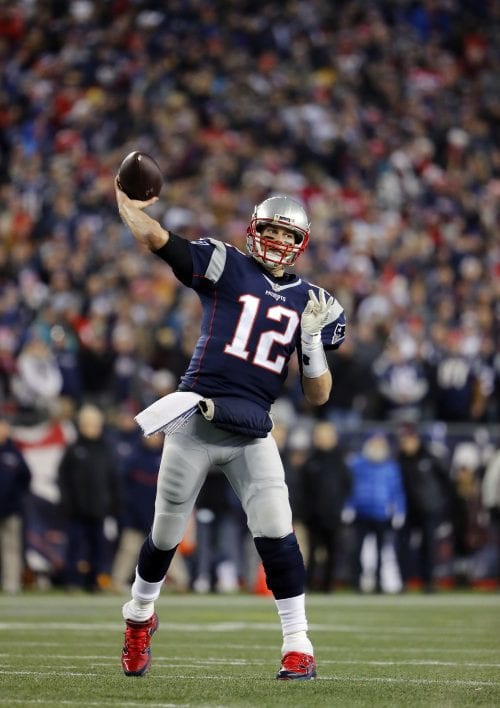We’re talking a lot about goats this week. Not the animals. But people who fit the definition of “Greatest of All Time.”
Since Thursday was Tom Brady’s 40th birthday (is there anybody out there who doesn’t know who he is, and needs the term “New England Patriots quarterback” in front of his name?) he’s the person — at least up here — to whom the term GOAT is applied.
It got so silly that the Patriots decided to bring in goats with team jerseys on them to mark the occasion of Brady’s 40th birthday.
Now, we can acknowledge that Brady is very good. He’s quarterbacked the Patriots to five Super Bowls and taken them to seven overall since he took over the job in 2001.
No other National Football League quarterback has done this. Not Joe Montana. Not Terry Bradshaw. Not Aaron Rodgers. Not Peyton Manning. And not Dan Marino.
And while winning is certainly a significant barometer, it’s not the only yardstick. Having seen a lot of the aforementioned quarterbacks, I’d be hard-pressed to say definitively that Brady is head-and-shoulders better than any of them.
This doesn’t mean I think he’s a stiff. But it means he’s been privileged to play for a coach who is generally acknowledged as the best ever (and that’s a subject for debate too, though perhaps we can save it for another day).
But it does beg the question: do the players make the coaches better, or is it the other way around? I don’t think there’s a real answer to the question.
There are two sports where players and coaches can build a type of symbiotic relationship: basketball and football. There’s a saying in baseball that momentum goes only as far as the next day’s starting pitcher. And in hockey, if the goalie is standing on his head, nothing else matters.
Soccer has had its share of dominating players, but the game is not set up to allow one of them to completely take over a game.
But sometimes, especially in football and basketball, it’s tough to separate the brilliance of players from coaches. It doesn’t happen as often as you’d think. For example, there’s no arguing that Vince Lombardi was the architect of those Green Bay Packer glory years, even though it’s just as true that a good coach can only take you so far. At some point, you need thoroughbreds.
Also, Chuck Noll built that great Pittsburgh Steelers team of the 1970s not around Bradshaw, but around the “Steel Curtain” defense, Franco Harris and Rocky Bleier. Bradshaw benefited from it, but there’s no way he was the focal point.
Conversely, Phil Jackson was fortunate for his entire coaching career to have two superstars who would have won no matter who was coaching: Michael Jordan (who gets GOAT votes here) and Kobe Bryant.
But as to the question of who made whom better, there are three prototype examples that spring to mind. One of them is the Bill Walsh-Joe Montana combination.
Montana was a third-round draft choice who flourished under Walsh, who was seen as an offensive genius. Together, they won three Super Bowls, including a dramatic come-from-behind victory over the Cincinnati Bengals in 1989. However, Montana won a fourth title under George Seifert.
The other two examples are local. Did Red Auerbach create Bill Russell or was it the other way around? Those who argue Russell was the architect of the relationship say Red never won anything until he came along. But the other side of the argument is that Auerbach knew instinctively what Russell’s best attributes were and built the Celtics around them. This is the type of argument you could have all day, but the results speak for themselves. The two of them won eight straight NBA titles, and I don’t care whether basketball players in the 1960s weren’t as athletic are they are today. Eight straight titles is a major accomplishment.
Auerbach was smart enough not to ask Russell to do too much. His defense, his ability to block shots and rebound, and his overall leadership and maniacal drive to win was plenty.
This is where we’re at with Belichick and Brady. Who defines whom? If Brady is the GOAT, what does that make Belichick?
This is the perfect player-coach relationship. It’s obvious Brady, early on, bought into Belichick’s philosophy, and it’s obvious that Brady has both the personality and cachet, by way of winning five Super Bowls, to be a leader in the locker room.
Belichick, however, for all his antisocial tendencies, is every bit a part of this equation. It has to be a pretty well-accepted fact that no other coach in the NFL, at the time, saw in Brady what Belichick saw or he’d have been drafted by somewhat else. And no other coach would have chosen Brady over Drew Bledsoe to lead the team once Bledsoe recovered from the injury that put him out of action for most of 2001.
Belichick obviously saw something in the skinny kid from the University of Michigan and had enough confidence to stick with him, and mold him into what he is today.
And this is one of those instances where it really is fair to ask whether either would be even half a GOAT without the other.

